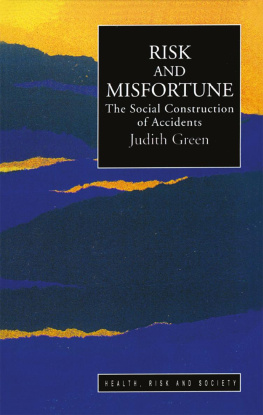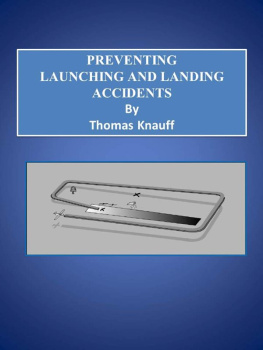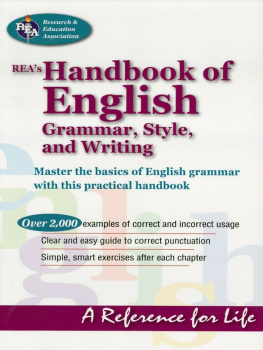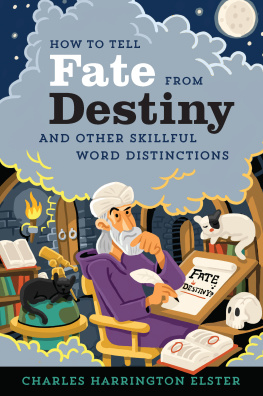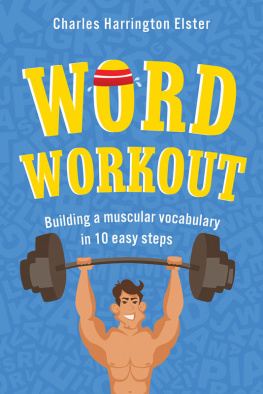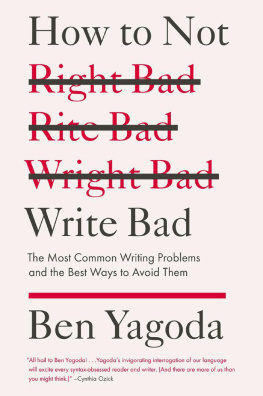The ability to use language is like the ability to drive a car. You can be an excellent driver without knowing the difference between a carburetor and a distributor, but youd better be able to distinguish the brake from the gas pedal.
Mark Davidson, Right, Wrong, and Risky
It seems astonishing that so much bad writing should find its way into print when so much good advice is to be had.
Robertson Davies, The Enthusiasms of Robertson Davies
It is not, of course, any single violation of meaning or idiom, however frequent, that harms the common property of language. If frequent, the error becomes generalbecomes the languagein the traditional way of change. What does harm, now and hereafter, is the loss of the feeling for words, the disappearance of any instinct and any preferences about their formation and combination.
Jacques Barzun, A Word or Two Before You Go
Without minute neatness of execution the sublime cannot exist.
William Blake, English poet and artist (17571827)
Abusus non tollit usum.
Misuse does not nullify proper use.

For Myrna,
con abrazos y besos
Contents
Introduction
In what some have called the greatest match in tennis history, Rafael Nadal defeated Roger Federer to win the 2008 Wimbledon championship. When Federers final shot failed to clear the net, the elated but exhausted Nadal collapsed on the court.
The conquering Spanish hero was lying prone on the grass, wrote Charles Bricker of the South Florida Sun Sentinel in a syndicated report that appearedits glaring error intactin scores of other newspapers across America, including my local fishwrap, The San Diego Union-Tribune, which ran a photo of Nadal lying flat on his back with his arms stretched out.
What was the error that slipped by all those yawning copyeditors? The misuse of prone to mean lying on ones back. Prone means lying facedown, on ones belly. The word supine means lying on ones back. Rafael Nadal was lying supine on the grass of Wimbledons center court, but nobody seemed to know it.
You could call this confusion of prone with supine a slip, a blunder, or, if you want to be fancy, a solecism. If you want to be fancier still, you could use the precise rhetorical term for it: catachresis . Whatever you want to call it, when a sentence hits an icy patch and skids off the road into a tree, I call it an accident of style.
Just like automobile accidents, accidents of style occur all over the English-speaking world, in print and on the Internet, thousands of times every daynot everyday , which is an adjective meaning daily or ordinary and always modifies a noun, as in everyday life or everyday problems . (Even the illustrious New York Times Magazine is guilty of this blunder. See .)
Accidents of style happen when people are merrily writing along and, for one reason or another, fail to observe the rules of the road. Maybe they get distracted and make a wrong turn. Maybe they get too cavalier and lose control. Maybe theyve forgotten what the operators manual says to do, or they never bothered to read it.
As the misuse of prone I cited illustrates, accidents of style are not restricted to writing that is hasty or unpolished. They occur in all avenues of communication, from the unsupervised byways of e-mail and blogs to the edited superhighways of newspapers, magazines, and books. Even in the most reputable publications, accidents of style are surprisingly common incidentsnot incidences, an erroneous plural of incident and instance that repeatedly runs sentences off the road and into trees.
Accidents of style can happen anywhere, anytime (not any time ). They can be minor, a fender bender that makes the reader wince for a moment but soldier on, and they can be fatal, a fiery wreck of mangled prose that destroys the writers credibility and kills the readers patience. Finally, accidents of style happen to everyone, to the amateur and professional alikealthough, as with driving, the experienced writer will have fewer accidents while the apprentice writer will, sadly, have less .
So what can you do to insure yourself against these accidents of style and ensure that you are a wrecklessnot a recklesswriter?
You can learn how not to write badly.
But, you may ask, shouldnt I aspire to write well rather than worry about making mistakes? Shouldnt I study good writing rather than bad? Of course you should, but if you dont know enough about what constitutes bad writing, how can you fully appreciate, much less emulate, what is good?
Anyone who puts words together for any serious purpose wants to make a favorable impression. And the best way to make a favorable impression, in life as well as in writing, is to know first what makes an unfavorable one.
The road to writing well begins with learning how to recognize and correct faulty composition. This book shows you how to steer around the ruts and potholes in that road and safely navigate its hairpin turns. Its a crash course in careful usage. Whether you write for work, for school, for pleasure, or for publication, The Accidents of Style will help you avoid hundreds of common word hazards and get the most mileage out of your efforts to drive home what you want to say.
A Note to the Reader
Most books of this kind are arranged either alphabetically, as dictionaries of usage, or in chapters covering various categoriesword choice, grammar, spelling, punctuation, and so on. This book takes a different approach.
The Accidents of Style is a meandering road trip along the hazardous highways of English usage, a peripatetic trek for writers of all levels. Your affable tour bus driver (a seasoned cicerone) will cover some rugged linguistic terrain, discussing 350 perilous points of interest along the way. The itinerary proceeds in order of increasing complexity from the rudiments to the punctilios. We will begin with the everyday blunders that trip up inexperienced writers and end with the niceties that nettle the most practiced ones. In short, the road gets trickier to navigate as you go along.
You can use The Accidents of Style as a reference, looking up specific topics in the index. Or you can read it linearly as a primer designed to teach you, step by step, how to become a wreckless writer, one who is not prone to accidents of style. For your enjoyment, and perhaps also exasperation, I have included a pretest (How Accident-Prone Are You?) and a posttest (Are You Roadworthy?) so you can assess your progress toward wrecklessness, if you are so inclined.
I suggest taking the whole tour first and then using this book as you would a photo album, consulting particular snapshots whenever you need to refresh your memory. But you are the accidental tourist and I am merely the guide. Whether you open The Accidents of Style for an excursion or an expedition, a sojourn or an extended stay, I am confident that your journey will be enlightening.
How Accident-Prone Are You?
The following twenty sentences contain 101 common accidents of style. See how many of them you can findand how many you miss. A score of 90 or better qualifies you as a wreckless writer. The number in parentheses after each sentence shows the number of errors in that sentence. Answers follow the test.
- Because I can not afford a car, I ride two busses to work everyday. (3)
- Due to the fact that our hot water heater is broken, we wont be able to run the dishwasher or take showers for awhile. (3)
- Up until now we didnt know that this bacteria causes the illness, so if people dont want to get sick they better wash there hands. (4)


